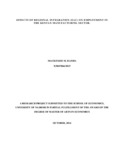| dc.contributor.author | Elisha, Mackenzie | |
| dc.date.accessioned | 2016-11-15T11:11:14Z | |
| dc.date.available | 2016-11-15T11:11:14Z | |
| dc.date.issued | 2016 | |
| dc.identifier.uri | http://hdl.handle.net/11295/97297 | |
| dc.description.abstract | Despite various policy interventions since independence, the sector’s contribution to GDP seems to have stagnated at about 10 per cent, with marginal decline recently. Following the establishment of the East African Community, the number of firms exporting to the East African community has increased over time. However, this seems not to be contributing to an increase in the growth of employment levels in Kenya’s manufacturing sector. One of the major development challenges Kenya is facing is stimulating economic growth through an economic strategy that is export-led while at the same time upholding increase in high quality employment.The study will investigate whether the East African Community regional integration has increased or decreased employment in Kenya’s manufacturing industry. The study will adopt time series OLS estimation technique using data from 1980 to 2014. The data will be sourced from the Central Bank of Kenya, Kenya National Bureau of Statistics and the World Bank. The study is expected to make policy recommendations aimed at ensuring regional integration is used for effective growth of employment levels in the manufacturing sector. | en_US |
| dc.language.iso | en | en_US |
| dc.publisher | University Of Nairobi | en_US |
| dc.rights | Attribution-NonCommercial-NoDerivs 3.0 United States | * |
| dc.rights.uri | http://creativecommons.org/licenses/by-nc-nd/3.0/us/ | * |
| dc.title | Effects of Regional Integration (Eac) on Employment in the Kenyan Manufacturing Sector. | en_US |
| dc.type | Thesis | en_US |



